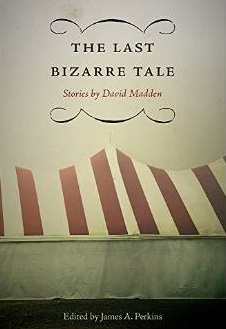By Caitlin Mattera
In his introduction to The Last Bizarre Tale, editor James A. Perkins frames David Madden’s fiction by drawing the reader’s attention to the short stories’ prominent, unusual craft elements and innovative points of view. Madden’s collection, composed of stories culled from more than half century of publications, transitions from traditional, first and third-person narratives to experiments in form like the interrupted monologue of “The Singer” or “Second Look Presents: The Rape of an Indian Brave,” the detailed script of a 60 Minutes-esque documentary.
Bizarre is an apt description of Madden’s work: he thwarts reader’s expectations and feeds off their curiosity, often revealing crucial information and identifying details only on the story’s final page. Though in some places the dialogue seems stilted, his characters breathe. The reader may doubt that this universe holds individuals who talk and behave the way Madden’s characters do, at least until he or she begins to recognize them. Madden’s characters are our university professors, museum guards and cinema ushers, the disenfranchised homeless we hardly notice as we pass them on the street. Particularly well-realized are Paul Gaddis, the erstwhile novelist at the center of “A Secondary Character,” and Greta, the narrator’s love interest in “Hurry Up Please It’s Time.” Although many of Madden’s stories take place in the mid-to late-20th century, the best deal with contemporary concerns in relevant ways and create a sense of immediacy. If he occasionally seems unconcerned with the questions his characters pose, Madden’s care is evident in his compelling depictions of the evocative settings and everyday abnormalities of American life.
In Madden’s strongest stories, the reader cares about each character, almost without intending to. The gradual revelations of biographical and plot information, rather than impeding the action, establish momentum and wheel the stories along. And if some of Madden’s unconventional craft components result (and revel) in an intentionally subdued and objective tone, the few stories that weave together expressed emotion and dramatic action reward both writer and reader exponentially.
Perhaps the strongest story is the anomalous memoir-fiction piece, “James Agee Never Lived in This House.” The story details Madden’s own rumination on his personal relationship with an influential writer before segueing into a letter from the woman who now owns Agee’s house. The transition feels abrupt at first; Madden marks the change using only an ellipsis. However, as the woman’s narrative progresses and Madden delves into the woman’s frustration, the epistolary form allows her to express both her weariness and unexpected charm. By interweaving two tangentially related, fictional and autobiographical narratives, Madden demonstrates both his greatest strength and the driving force of his collection: the capturing of a bizarre world through unconventional eyes.
Caitlin Mattera (ΦBK, Drew University, 2013) graduated summa cum laude from Drew with bachelor’s degrees in English and Classics, and a minor in Writing. She is currently pursuing graduate study at Drew University in preparation to become a secondary school English teacher.




